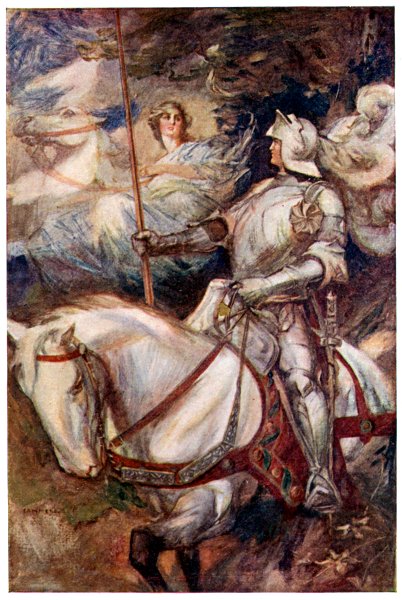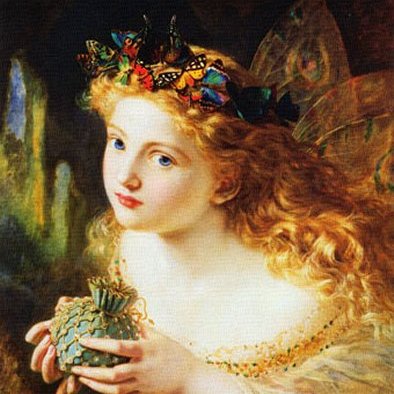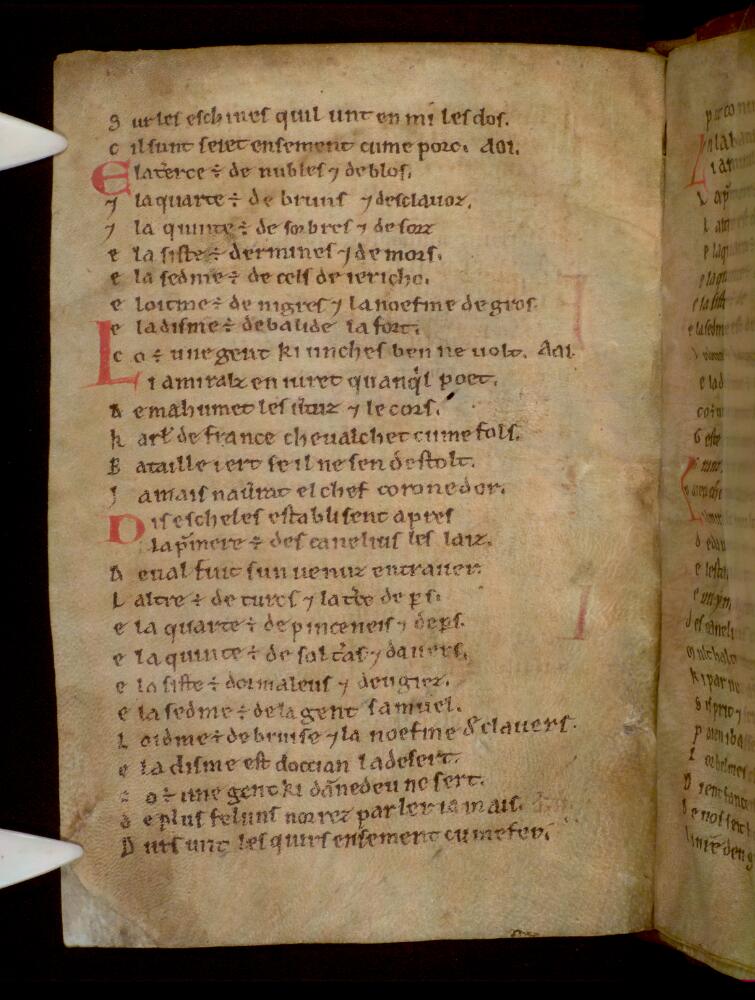|
Guigemar
"Guigemar" is a Breton lai, a type of narrative poem, written by Marie de France during the 12th century. The poem belongs to the collection known as ''The Lais of Marie de France''. Like the other lais in the collection, ''Guigemar'' is written in the Anglo-Norman language, a dialect of Old French, in rhyming octosyllabic couplets. "Guigemar" is one of the works in which the author explicitly gives her name as "Marie." In the prologue of this lai, she proclaims two goals for her work: to give rightful praise to people who have earned it, despite what envious rivals may have said; and to present the stories behind certain songs that were well-known at the time. It has been suggested that the prologue to "Guigemar" predates the overall prologue to the ''Lais'' in the Harley 978 manuscript, the only manuscript that records all twelve of Marie's known lais. Plot Guigemar, son of a loyal vassal to the King of Brittany, is a courageous and wise knight, who despite his many qualities, has ... [...More Info...] [...Related Items...] OR: [Wikipedia] [Google] [Baidu] |
Guihomar II, Viscount Of Léon
Guihomar II de Léon (died in 1103) was a Viscount of Léon. He is said to have succeeded his grandfather Guihomar I. Origins Guihomar is said to be the son of a man named Ehuarn. But according to Joëlle Quaghebeur, this Ehuarn was actually a "Viscount from Cornouaille", that is to say a Viscount of Le Faou. It seems that Guihomar II succeeded his supposed grandfather and namesake Guihomar I. A charter of the Cartulary of Saint-Georges de Rennes also mentions a Guihomar, son of Alan, himself named son of Guihomar in another charter in the same cartulary. Guihomar might then be the son of Ehuarn and a daughter or a granddaughter of Guihomar I. Guihomar's death is mentioned in the ''Chronicon Britannicum''. It is specified that Guihomar II was killed in 1103 by his own subjects. Possible family tree Alan of Léon │ ├──> Guihomar I of Léon († after 1040) │ │ │ ├──> ... [...More Info...] [...Related Items...] OR: [Wikipedia] [Google] [Baidu] |
Marie De France
Marie de France ( fl. 1160 to 1215) was a poet, possibly born in what is now France, who lived in England during the late 12th century. She lived and wrote at an unknown court, but she and her work were almost certainly known at the royal court of King Henry II of England. Virtually nothing is known of her life; both her given name and its geographical specification come from her manuscripts. However, one written description of her work and popularity from her own era still exists. She is considered by scholars to be the first woman known to write francophone verse. Marie de France wrote in Francien, with some Anglo-Norman influence. She was proficient in Latin, as were most authors and scholars of that era, as well as Middle English and possibly Breton. She is the author of the ''Lais of Marie de France''. She translated Aesop's Fables from Middle English into Anglo-Norman French and wrote ''Espurgatoire seint Partiz'', '' Legend of the Purgatory of St. Patrick'', based upon a ... [...More Info...] [...Related Items...] OR: [Wikipedia] [Google] [Baidu] |
The Lais Of Marie De France
The ''lais'' of Marie de France are a series of twelve short narrative Breton lais by the poet Marie de France. They are written in Anglo-Norman and were probably composed in the late 12th century, most likely between 1155-1170. The short, narrative poems generally focus on glorifying the concept of courtly love by the adventures of their main characters. Marie's lais are thought to form the basis for what would eventually become the genre known as the Breton lais. Despite her stature in Anglo-Norman literature and medieval French literature generally, little is known of Marie herself, but it is thought that she was born in France and wrote in England. Literary character Marie de France's lais, told in octosyllables or eight-syllable verse, are notable for their celebration of love, individuality of character, and vividness of description, hallmarks of the emerging literature of the times. Five different manuscripts contain one or more of the lais, but only one, Harley 978, a ... [...More Info...] [...Related Items...] OR: [Wikipedia] [Google] [Baidu] |
Guiomar (Arthurian Legend)
Guiomar is the best known name of a character appearing in many medieval texts relating to the Matter of Britain, Arthurian legend, often in relationship with Morgan le Fay or a similar Fairy Queen, fairy queen type character. In medieval literature His earliest known appearances are as Graelent, Guingamor and Guigemar, the titular character of three 12th-century Breton lai "fairy lais" (''lais féeriques''): ''Graelent'', ''Guingamor'' and ''Guigemar'', each telling a similar story. There, he is a king's relative or vassal who, after rejecting the advances of the unnamed queen (the king's adulterous and jealous wife), becomes a lover of a fairy queen known only as the Fairy Mistress (a figure considered to represent Morgan le Fay, Morgan) and is taken to an Otherworld (Avalon). All of these texts are related to Marie de France's ''Lanval'', where the human queen character is Guinevere. Guinguemar (''Guigomar'', ''Guingomar'', ''Gryngamore'') is one of the vassals of King Arthu ... [...More Info...] [...Related Items...] OR: [Wikipedia] [Google] [Baidu] |
Generides
''Generides'' or ''Generydes'' is an English verse romance, originating in the English Midlands and dated to the end of the 14th century. It survives in two different lengthy forms. The hero Generides is born as an illegitimate son of the King of India, and after adventures marries a princess of Persia and becomes ruler of both India and Persia. The original, which may have been in Middle English or French, appears to have been a compilation of the fourteenth century. Despite the wide use of Eastern names and locations, these do not appear to have any particular significance, and though many analogues can (and have) been drawn between it and various Indian and Persian tales, the characters and episodes are familiar ones in medieval romances. As in the romance ''Guigemar'', one of the hero's parents is already married to a cruel spouse, and some of the scene suggest deliberate imitiation of that romance; as in the romance ''Erec'', the father is woken the next morning by the lady' ... [...More Info...] [...Related Items...] OR: [Wikipedia] [Google] [Baidu] |
Breton Lai
A Breton lai, also known as a narrative lay or simply a lay, is a form of medieval French and English romance literature. Lais are short (typically 600–1000 lines), rhymed tales of love and chivalry, often involving supernatural and fairy-world Celtic motifs. The word "lay" or "lai" is thought to be derived from the Old High German and/or Old Middle German ''leich'', which means play, melody, or song, or as suggested by Jack Zipes in ''The Oxford Companion to Fairy Tales'', the Irish word ''laid'' (song).Zipes, 62 Zipes writes that Arthurian legends may have been brought from Wales, Cornwall and Ireland to Brittany; on the continent the songs were performed in various places by harpists, minstrels, storytellers.Zipes, Jack, ''The Oxford Companion to Fairytales''. Oxford UP. 2009 62-63 Zipes reports the earliest recorded lay is Robert Biker's Lai du Cor, dating to the mid- to late-12th century. The earliest of the Breton lais to survive is probably ''The Lais of Marie de Fra ... [...More Info...] [...Related Items...] OR: [Wikipedia] [Google] [Baidu] |
Medieval French Literature
Medieval French literature is, for the purpose of this article, Medieval literature written in Oïl languages (particularly Old French and early Middle French) during the period from the eleventh century to the end of the fifteenth century. The material and cultural conditions in France and associated territories around the year 1100 unleashed what the scholar Charles Homer Haskins termed the " Renaissance of the 12th century" and, for over the next hundred years, writers, " jongleurs", "clercs" and poets produced a profusion of remarkable creative works in all genres. Although the dynastic struggles of the Hundred Years' War and the Black Death pandemic of the fourteenth century in many ways curtailed this creative production, the fifteenth century laid the groundwork for the French Renaissance. Language Up to roughly 1340, the Romance languages spoken in the Middle Ages in the northern half of what is today France are collectively known as "ancien français" ("Old French") ... [...More Info...] [...Related Items...] OR: [Wikipedia] [Google] [Baidu] |
Courtly Love
Courtly love ( oc, fin'amor ; french: amour courtois ) was a medieval European literary conception of love that emphasized nobility and chivalry. Medieval literature is filled with examples of knights setting out on adventures and performing various deeds or services for ladies because of their "courtly love". This kind of love is originally a literary fiction created for the entertainment of the nobility, but as time passed, these ideas about love changed and attracted a larger audience. In the high Middle Ages, a "game of love" developed around these ideas as a set of social practices. "Loving nobly" was considered to be an enriching and improving practice. Courtly love began in the ducal and princely courts of Aquitaine, Provence, Champagne, ducal Burgundy and the Norman Kingdom of Sicily at the end of the eleventh century. In essence, courtly love was an experience between erotic desire and spiritual attainment, "a love at once illicit and morally elevating, passionate and ... [...More Info...] [...Related Items...] OR: [Wikipedia] [Google] [Baidu] |
Anglo-Norman Literature
Anglo-Norman may refer to: *Anglo-Normans, the medieval ruling class in England following the Norman conquest of 1066 *Anglo-Norman language **Anglo-Norman literature * Anglo-Norman England, or Norman England, the period in English history from 1066 till 1154 *Anglo-Norman horse, a breed from Normandy, France *Anglo-Norman Isles, or Channel Islands, an archipelago in the English Channel * CSS ''Anglo-Norman'', a gunboat of the Confederate Navy See also *Cambro-Normans *Normans in Ireland *Scoto-Norman The term Scoto-Norman (also Franco-Scottish or Franco-Gaelic) is used to describe people, families, institutions and archaeological artifacts that are partly Scottish (in some sense) and partly Anglo-Norman (in some sense). It is used to refer to ... {{disamb Language and nationality disambiguation pages ... [...More Info...] [...Related Items...] OR: [Wikipedia] [Google] [Baidu] |
Chivalric Romance
As a literary genre, the chivalric romance is a type of prose and verse narrative that was popular in the noble courts of High Medieval and Early Modern Europe. They were fantastic stories about marvel-filled adventures, often of a chivalric knight-errant portrayed as having heroic qualities, who goes on a quest. It developed further from the epics as time went on; in particular, "the emphasis on love and courtly manners distinguishes it from the ''chanson de geste'' and other kinds of epic, in which masculine military heroism predominates." Popular literature also drew on themes of romance, but with ironic, satiric, or burlesque intent. Romances reworked legends, fairy tales, and history to suit the readers' and hearers' tastes, but by c. 1600 they were out of fashion, and Miguel de Cervantes famously burlesqued them in his novel ''Don Quixote''. Still, the modern image of "medieval" is more influenced by the romance than by any other medieval genre, and the word ''medieva ... [...More Info...] [...Related Items...] OR: [Wikipedia] [Google] [Baidu] |
Ovid
Pūblius Ovidius Nāsō (; 20 March 43 BC – 17/18 AD), known in English as Ovid ( ), was a Roman poet who lived during the reign of Augustus. He was a contemporary of the older Virgil and Horace, with whom he is often ranked as one of the three canonical poets of Latin literature. The Imperial scholar Quintilian considered him the last of the Latin love elegists.Quint. ''Inst.'' 10.1.93 Although Ovid enjoyed enormous popularity during his lifetime, the emperor Augustus banished him to Tomis, a Dacian province on the Black Sea, where he remained a decade until his death. Overview A contemporary of the older poets Virgil and Horace, Ovid was the first major Roman poet to begin his career during Augustus's reign. Collectively, they are considered the three canonical poets of Latin literature. The Imperial scholar Quintilian described Ovid as the last of the Latin love elegists.Quint. ''Inst.'' 10.1.93 He enjoyed enormous popularity during his lifetime, but the emperor Augus ... [...More Info...] [...Related Items...] OR: [Wikipedia] [Google] [Baidu] |
Remedia Amoris
''Remedia Amoris'' (''Love's Remedy'' or ''The Cure for Love'') . 2 ADis an 814-line poem in Latin by Roman poet Ovid. In this companion poem to '' The Art of Love'', Ovid offers advice and strategies to avoid being hurt by love feelings, or to fall out of love, with a stoic overtone. Genre ''Remedia Amoris'' fell into the Hellenistic category of didactic poetry, often carried out on mock-solemn subjects. Goal and methods Ovid's goal was to provide, for men and women alike, advice on how to escape safely from an unhappy love affair - emotional bondage - without falling into the tragic ends of such legendary figures as Dido or Medea. Among the techniques he suggested were: keeping busy; travelling; avoiding wine and love poetry (!); and concentrating on the beloved's defects rather than their strong points. Critical reactions *Alexander Neckam in the Middle Ages thought that ''De Remedio Amoris'' was ''the'' most important book of Ovid's for scholars to read. *Victorian views, ... [...More Info...] [...Related Items...] OR: [Wikipedia] [Google] [Baidu] |





